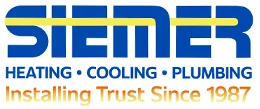When it comes to heating and cooling your home, most people are familiar with furnaces, air conditioners, and thermostats. But there’s one essential piece of HVAC equipment that often goes unnoticed: the air handler.
An air handler is a vital component of your HVAC system that’s responsible for moving conditioned air throughout your home. Think of it as the middleman between your heating or cooling equipment and the ductwork that delivers air to every room.
A typical air handler contains several internal parts that work together to circulate air efficiently and effectively:
- A blower motor (also called a fan) that moves air throughout your duct system
- An evaporator coil that either cools or warms the air, depending on the season
- Filters to trap dust, dander, and airborne contaminants
- Various controls and electronics that regulate operation and safety
Each of these components plays a crucial role in ensuring your HVAC system operates reliably, quietly, and at peak efficiency. Without a properly functioning air handler, your system can’t deliver consistent comfort or maintain healthy indoor air quality.
Air Handler vs Furnace
While air handlers and furnaces might look similar from the outside, they serve very different functions within your HVAC system. A furnace generates heat using gas or electricity, whereas an air handler circulates air, whether it’s cooled or heated by a heat pump.
Homeowners using heat pump systems rely on air handlers for both heating and cooling functions. If your home doesn’t have a furnace, your air handler is likely the main driver of airflow in every season.
What Does an Air Handler Do in a Home HVAC System?
To understand how air handlers support home comfort, it helps to see how they interact with other parts of your HVAC system. Their primary job is to ensure that treated air moves efficiently through the home, providing even temperature control in every room.
Here’s a step-by-step breakdown of what an air handler does:
- Air is pulled in from your home through return ducts.
- It passes through a filter, removing dust, allergens, and other particles.
- The filtered air then moves across the evaporator coil:
- In summer, the coil cools the air (paired with your AC or heat pump).
- In winter, the heat pump may provide warm air.
- The blower motor pushes this conditioned air through your supply ducts.
- Air is distributed to the rooms in your home, completing the cycle.
This cycle repeats continuously while your system is operating, helping maintain your desired temperature and indoor air quality. A properly sized and maintained air handler will operate quietly and provide balanced airflow throughout your living space.
Types of Air Handlers
Different types of air handlers offer various levels of performance, energy efficiency, and comfort. Choosing the right type depends on your home’s size, your HVAC system’s configuration, and your personal preferences for noise and energy savings.
Here are the three main types of residential air handlers.
1. Single-Speed Air Handlers
These operate at one fixed speed and are typically the most affordable option upfront. While reliable, they’re less efficient and can be noisier compared to other models.
2. Multi-Speed Air Handlers
These offer improved comfort by operating at different speeds depending on demand. They provide better humidity control and more consistent temperatures than single-speed models.
3. Variable-Speed Air Handlers
These are the gold standard in terms of energy efficiency and comfort. Variable-speed motors can run at low speeds for longer periods, resulting in better filtration, quieter operation, and more even temperature control.
Each type has its pros and cons. At Siemer, we help you weigh your options based on real-world performance, not just specs on a label. Whether you’re building new or upgrading, we’ll make sure your air handler matches your HVAC system and your needs.
When Would You Need an Air Handler?
Air handlers are essential for homes that use a heat pump system, but that’s not the only time you might need one. You may also need to install or upgrade your air handler when making changes to other parts of your HVAC system.
Here are common scenarios when an air handler is required or recommended:
- You’re replacing your heat pump or AC system and need a matched indoor unit
- Your current air handler is old, inefficient, or breaking down frequently
- You’re upgrading to a variable-speed system for improved comfort and savings
Upgrading your air handler can significantly improve airflow, energy efficiency, and system lifespan. If you’re unsure whether you need one, our team can perform an assessment and guide you toward the most cost-effective solution.
The Unsung Hero of Your HVAC System—And the Team That Keeps It Running
Your air handler may not be the flashiest part of your HVAC system, but it’s absolutely essential to your home’s year-round comfort. Whether you’re cooling off in July or warming up in January, the air handler quietly keeps air flowing, filtered, and at the right temperature.
And when it comes to keeping that system in peak condition, Siemer Heating, Cooling & Plumbing has your back. Our team is proud to bring world-class HVAC expertise with the care and service of a hometown business.
Since 1989, we’ve proudly served the Greater Cincinnati area with:
- Family-owned, hometown service rooted in honesty and accountability
- Certified technicians who treat your home like their own
- Upfront, honest pricing—so there are never any surprises
- Fast, friendly, and professional support every time you call
Ready for better comfort and cleaner air? Trust Siemer for expert air handler services. Call 219-923-9234 to schedule your service or get a free estimate today.

